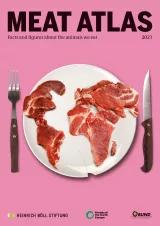Meat Atlas 2021
Main takeaways from the Meat Atlas 2021.

- Global meat production is increasing. But to protect BIODIVERSITY AND THE CLIMATE, the developed world WILL HAVE TO HALVE ITS CONSUMPTION OF MEAT.
- More than one billion people around the world earn their living by KEEPING LIVESTOCK. Traditional and nature-friendly animal husbandry is coming under pressure from INDUSTRIALIZED AGRICULTURE.
- Almost two-thirds of the world’s 600 million poor livestock keepers are WOMEN. They face disadvantages because they have LIMITED ACCESS to land, services and farm ownership.
- CONFLICTS over land are on the rise, in part because of industrial meat production. More and more people are being killed for defending the RIGHT TO LAND.
- The use of ANTIBIOTICS IN ANIMAL HUSBANDRY is resulting in more and more MICROBIAL RESISTANCE. This threatens the effectiveness of antibiotics, one of the most important types of treatment in human medicine.
- The leading producers of fodder crops are among the largest users of PESTICIDES – which contaminate groundwater and harm BIODIVERSITY.
- The five biggest MEAT AND MILK PRODUCERS emit the same volume of CLIMATE-DAMAGING GREENHOUSE GASES as Exxon, AN OIL GIANT.
- RE-WETTING THE PEATLANDS that occupy 3 percent of EU farmland would avoid climate-damaging gas emissions by UP TO ONE QUARTER.
- In many countries, habits, role models and ADVERTISING, along with cultural traditions, combine to promote meat consumption. The food industry is PROFITING from the status quo.
- FINANCIAL INSTITUTIONS like public and private banks, pension, and investment funds, support industrial animal production with HUNDREDS OF BILLIONS of euros.
- MEAT SUBSTITUTES can reduce meat consumption. The market is growing fast. PLANT-BASED alternatives currently play a big role; CELL-BASED meat – not yet.
- Despite the global impact of meat, no country in the world has a STRATEGY TO REDUCE CONSUMPTION or TRANSFORM PRODUCTION. Governments can play a major role through LAWS.

